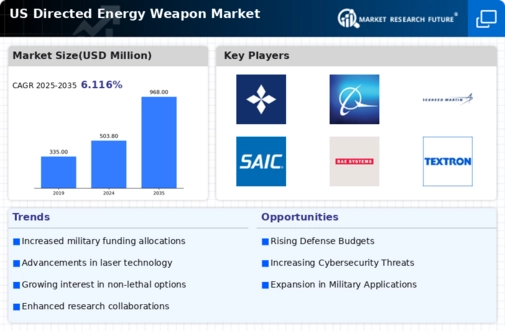Emerging Military Strategies
The evolution of military strategies in the US has increasingly incorporated directed energy weapons as a pivotal component. This shift is driven by the need for precision and reduced collateral damage in combat scenarios. The directed energy-weapon market is expected to benefit from this trend, as military planners seek to enhance operational effectiveness. The US Department of Defense has allocated substantial budgets towards research and development in this area, with estimates suggesting an increase of approximately 15% in funding for directed energy systems over the next five years. This strategic focus indicates a long-term commitment to integrating these technologies into military operations, thereby propelling the directed energy-weapon market forward.
Legislative Support for Advanced Weaponry
Legislative support for the development and deployment of advanced weaponry is a crucial driver for the directed energy-weapon market. Recent policy initiatives in the US have emphasized the need for innovative defense solutions to maintain military superiority. This legislative backing is reflected in increased funding for research and development, as well as streamlined processes for acquiring directed energy systems. The directed energy-weapon market stands to gain from this supportive environment, with projections indicating a potential market size of $5 billion by 2030. Such legislative measures not only facilitate technological advancements but also foster collaboration between government and private sector entities, further enhancing market dynamics.
Technological Integration in Defense Systems
The integration of advanced technologies into existing defense systems is a significant driver for the directed energy-weapon market. As the US military modernizes its arsenal, there is a growing emphasis on incorporating directed energy capabilities into platforms such as aircraft, naval vessels, and ground vehicles. This integration is not only aimed at enhancing combat effectiveness but also at improving cost-efficiency. Reports indicate that the directed energy-weapon market could see a growth rate of around 20% annually as these technologies become more prevalent in defense contracts. The ability to leverage existing systems while adding directed energy capabilities is likely to attract investment and innovation, further stimulating market growth.
Growing Demand for Energy-Efficient Solutions
The increasing demand for energy-efficient solutions in military operations is driving interest in directed energy weapons. These systems offer the potential for lower operational costs compared to traditional munitions, as they rely on electrical energy rather than physical projectiles. The directed energy-weapon market is poised for growth as defense budgets become more scrutinized, and the need for sustainable solutions becomes paramount. Analysts project that the market could experience a compound annual growth rate (CAGR) of 18% over the next decade, as military organizations seek to balance effectiveness with environmental considerations. This trend underscores the strategic importance of directed energy technologies in future defense planning.
Increased Focus on Counter-Drone Technologies
The proliferation of unmanned aerial vehicles (UAVs) poses new challenges for national security, prompting a heightened focus on counter-drone technologies. Directed energy weapons are emerging as a viable solution for neutralizing these threats, offering a cost-effective and precise means of engagement. The directed energy-weapon market is likely to expand as military and law enforcement agencies in the US invest in these systems to protect critical infrastructure and personnel. Recent assessments suggest that the market for counter-drone directed energy systems could reach $1 billion by 2027, reflecting the urgency and importance of addressing this evolving threat landscape.





















Leave a Comment